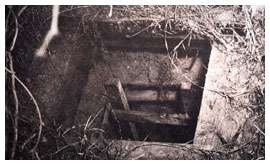Camp Papago Park
Camp Papago Park was a prisoner of war (POW) facility located in Papago Park in the eastern part of Phoenix, Arizona. It consisted of five compounds, four for enlisted men and one for officers. The property now is divided between the Papago Park Military Reservation, belonging to the Arizona National Guard, a city park, residential neighborhoods and a car dealer's lot.[1]
Called Schlaraffenland—the land of milk and honey—by its mostly U-boat-crew inmates, Camp Papago Park was very different from Axis POW camps, especially with regard to how prisoners were treated:[1] Inmates were not required to work or study, though many chose to as a means of combating boredom (though mostly the latter, as there were only 700 volunteers for labor tasks). The camp had a theater where films were screened twice a week and the camp choir could practice. Much of this was discussed, along with anything else the prisoners who wrote The Papago Rundschau chose to include, in the camp’s newspaper.[1]
Escape

In December 1944, twenty-five POWs escaped from Camp Papago Park into the surrounding desert, among them Knight's Cross of the Iron Cross recipient Kapitänleutnant Hans-Werner Kraus. Originally thought to be impossible to tunnel through, the hard clay of the surrounding area turned out to be conducive to tunneling as it softened greatly when wet.[1] Over time, the escapees dug a tunnel 176 feet long, three feet high and half as wide, without being detected.[1] Though the guards proved easy to get past, the vast distances and desert terrain were insurmountable, resulting in most returning to the camp within a few weeks. One escapee turned himself in on seeing the camp’s planned Christmas menu.[1] Indeed, most of the escapees were aware that returning to Germany was nearly impossible and had “escaped” as more of a prank.[1] This did not mean all had abandoned any hope of making it home, and a few of the men brought along boards they intended to fashion into a raft. This would then be used to float down the Salt River to the Gila River, which they had seen on local maps but not personally. Unfortunately for their plan, the river was not flowing at the time of their escape, and what they found was a dry arroyo instead.[1]
When two escapees were recaptured, subsequent events further illustrated differences between Axis and Allied POW operations: The two men dined with a local customs official at his home.[1] Later nearby residents came to see the escapees first hand after their story appeared in the news, as did a handicapped boy looking for a game of chess.
They brought in this little crippled boy. He didn't know anyone who could play chess with him, and he wanted to know if we knew how to play. I told Reinhard, in German, to let the kid win, because I thought we might win favor with our captors. And this kid didn't look like he had long to live, so why not let him beat the great captured war prisoners? He could tell his friends about it later.— Heinrich Palmer[1]
See also
- Arizona during World War II
- List of POW camps in the United States
- German Prisoners of War in the United States
References
External links
Coordinates: 33°28′15″N 111°56′57″W / 33.47070°N 111.94918°W